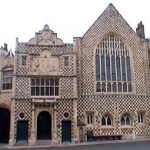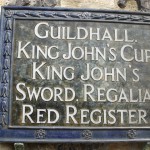 A few days ago I visited the ancient town of King’s Lynn. It was a memorable trip, not least for being booked-ended by glimpses of the great medieval cathedrals of Peterborough (underrated, I think) and Ely (the much-loved ‘Ship of the Fens’). Lynn, once one of the busiest sea-ports in Europe, had an eerie autumnal quietness; low clouds hung over the fenland approaches and the tide was disquietingly high in the Ouse estuary.
A few days ago I visited the ancient town of King’s Lynn. It was a memorable trip, not least for being booked-ended by glimpses of the great medieval cathedrals of Peterborough (underrated, I think) and Ely (the much-loved ‘Ship of the Fens’). Lynn, once one of the busiest sea-ports in Europe, had an eerie autumnal quietness; low clouds hung over the fenland approaches and the tide was disquietingly high in the Ouse estuary.
I spent some time in the borough archives, still housed in the Town Hall (access via the Old Gaol House). The medieval town archives of Lynn are breathtaking and include one of the finest collections of town charters in the country. But for me, the highlight was an initially unprepossessing paper book now blessed with the name of ‘The Red Register’ after its later binding. The register is a collection of town documents written up in this book from the year 1307. After turning some of its leaves and admiring the handwriting I put the register back in its archive box and made a brief note: ‘paper book; 1307; ?early’ and moved on.
In the early fourteenth century England’s writers habitually wrote, as we all know, with quill pens on sheets of parchment or vellum. And that’s true of writers in a variety of fields: in the church, the law courts, or in royal and local government. Here in Lynn, in 1307 we find a medieval writer (or probably writers) writing on quires of paper with the clear intention of binding them up as a book. The paper could not, of course, have been English: the first recorded English paper mill dates from only the 1490s, when a Hertford paper maker supplied paper to the printer William Caxton.
It was only after I returned home to Faversham (which coincidentally has a pretty mean collection of medieval charters) that I realised just how early the Lynn paper book was. In fact, consulting the endlessly-useful classic by Michael Clanchy From Memory to Written Record, I found that: ‘The earliest records made in England on paper come most appropriately from major seaports: a register from King’s Lynn beginning in 1307 and another from Lyme Regis in 1309’.
 The King’s Lynn Red Register is then, the earliest surviving English paper book. I realise that, had I been paying attention, I would have noticed it even has its own blue plaque outside the town-hall, though it doesn’t tell us why it’s important.
The King’s Lynn Red Register is then, the earliest surviving English paper book. I realise that, had I been paying attention, I would have noticed it even has its own blue plaque outside the town-hall, though it doesn’t tell us why it’s important.
It’s a common (and fair) assumption that paper books have something to do with printing. Books are printed on paper. There are a few black-tulip exceptions, usually very early (a few copies of the Gutenberg Bible and other incunables, including Caxtons, and of course a few copies of the wonderful Kelmscott Chaucer and other private press books; late revivals of vellum printing). There’s also a co-incidence of chronology: paper making, especially in England, takes off with the advent of printing. Conversely, we tend to think of medieval manuscripts as written on parchment or vellum.
On reflection I can now think of several examples of English medieval manuscripts on paper, mostly urban or legal registers from the fifteenth century (there’s even one here in Faversham). A few date from the period before printing, but very few from the fourteenth century. That makes the 1307 Red Register at Lynn truly remarkable.
It speaks of a confident leap-of-faith on behalf of the town government to make an important civic record on a material with such a short track-record in practice. Of course we know that Chinese and Islamic cultures used paper long before, but the first paper mills in Europe were not active before the 1270s (in Italy; where else?). Urban records were not mere shopping lists: they were the documents used by powerful ruling elites to protect the data which allowed them to carry out their day to day business in the knowledge that they were acting correctly and lawfully. Town documents were jealously guarded and treated with all the care and respect that a major business corporation would use to maintain and back-up its databases. That is one reason why medieval town records have such a good rate of survival.
To experiment with paper as a record-keeping technology was a brave and forward-looking move in 1307. Probably before its time, since it didn’t catch on for so long. Paper would turn out to have all kinds of advantages over parchment: it can be less bulky, it allows for much more rapid writing in new, faster hands, and ultimately it would become cheaper. By 1500, except for deeds and charters, paper would become dominant in record-keeping of all kinds. Perhaps most significantly, in the long run, it provided a perfect surface for printing.
 I’m fascinated by the people who made medieval administrative records. It seems to me that, just like the IT wizards of the 21st century, it is they who were experimenting with new technologies for recording day-to-day experience. The Red Register of Lynn is perhaps just one example of how far ahead of their time they could be. They were often people of extraordinary capability and imagination. It’s no coincidence that people such as Geoffrey Chaucer, controller of customs at London, was also a full-time administrative writer. It has been argued that the explosion of English lay-literacy in the fourteenth century came about in part through advances in literate technology among administrators in the great towns of England. That is another story and one I’m certainly encouraged to revisit after my archival explorations at Lynn…
I’m fascinated by the people who made medieval administrative records. It seems to me that, just like the IT wizards of the 21st century, it is they who were experimenting with new technologies for recording day-to-day experience. The Red Register of Lynn is perhaps just one example of how far ahead of their time they could be. They were often people of extraordinary capability and imagination. It’s no coincidence that people such as Geoffrey Chaucer, controller of customs at London, was also a full-time administrative writer. It has been argued that the explosion of English lay-literacy in the fourteenth century came about in part through advances in literate technology among administrators in the great towns of England. That is another story and one I’m certainly encouraged to revisit after my archival explorations at Lynn…
